|
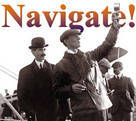
 Up
Up 
 Jump-Starting
Jump-Starting
The Langley
Laboratory

(You are here.)
 Down
Down




  Need
to Need
to
find your
bearings?
Try
these
navigation aids:
If
this is your first
visit, please stop by:
Something
to share?
Please:



|
|
Available in Française, Español, Português, Deutsch, Россию,
中文,
日本, and others.
 n
1911, at the inaugural banquet of the American Aeronautical Society
in New York City the attendees – Walcott among them – earnestly
discussed creating a “central aerodynamics laboratory” with a board
of advisors to direct the research in this emerging technology.
European nations already had similar organizations such as Britain’s
Advisory Committee for Aeronautics and France’s Central
Establishment for Military Aeronautics. Proposals were floated in
the press and before members of Congress with the U.S. Navy,
Massachusetts Institute of Technology, Bureau of Standards, and the
Smithsonian all vying for control of the proposed institution.
Outgoing President Taft established a committee to study the matter
in 1912, but its efforts came to nothing. n
1911, at the inaugural banquet of the American Aeronautical Society
in New York City the attendees – Walcott among them – earnestly
discussed creating a “central aerodynamics laboratory” with a board
of advisors to direct the research in this emerging technology.
European nations already had similar organizations such as Britain’s
Advisory Committee for Aeronautics and France’s Central
Establishment for Military Aeronautics. Proposals were floated in
the press and before members of Congress with the U.S. Navy,
Massachusetts Institute of Technology, Bureau of Standards, and the
Smithsonian all vying for control of the proposed institution.
Outgoing President Taft established a committee to study the matter
in 1912, but its efforts came to nothing.
In February
1913, a month after President Woodrow Wilson was inaugurated,
Walcott reopened Langley’s workshop at the Smithsonian, contracting
Albert Zahm to run it. Zahm was an aeronautics pioneer himself. He
had built the first wind tunnel in America at Catholic University in
1901, beginning operation just two months before the Wrights built
their tunnel. Zahm immediately began casting around for something
for the reincarnated Langley Aerodynamical Laboratory to do. It was
proposed that the Smithsonian erect a new building complete with
wind tunnels to replace the small workshop, but Walcott could not
raise the funding
On May 6 – “Langley Day,” according to a decree by the Smithsonian –
Glenn Curtiss was awarded the Langley Medal. This time Alexander
Graham Bell gave a speech that actually mentioned the
accomplishments of the recipient, although Walcott used the same
occasion to unveil a bronze tablet at the Castle that lionized
Langley’s contributions to aeronautics. Specifically, it
immortalized Langley's discovery of the "relations of speed and
angles of inclination to the lifting power of surfaces moving in the
air." While Langley had done research in this area, the effect was
actually discovered by a French artillery officer, Col. Du Chemin,
in 1829.
On May 23 of
that year, Walcott convened a committee to direct the workshop,
calling it the “Advisory Committee of the Langley Aerodynamical
Laboratory.” Walcott was the president, Zahm was the recorder, and
the rest of the committee was peopled with high-profile names in
aviation, among them Orville Wright and Glenn Curtiss.
All of this was bold politics. By
reopening the workshop and creating a capable governing body,
Walcott told Congress in effect, “Why create a new national
laboratory for aerodynamics when we’ve already got one up and
running?” The Langley Medal and the commemorative tablet emphasized
Langley’s successes. Even Langley Day (May 6) was calculated to draw
focus away from the failure of the 1903 Aerodrome A – 6 May
1896 was the date that Langley made his first successful flights
with unmanned aerodromes.
But
it didn’t work. Walcott’s opponents found an obscure law passed a
few years earlier that prevented executive agencies such as the
Smithsonian “from requesting the heads of departments to permit
members of their respective departments to meet at the Institution
and serve on an advisory committee.” They used this to force Walcott
to disband his Advisory Committee. Although Langley's workshop
remained open, it no longer had the political status afforded by the
famous and well-placed advisors.
In Their Own Words
|
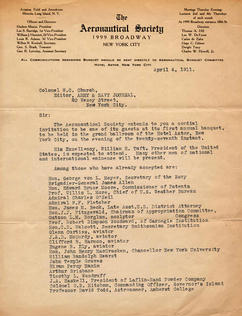
An invitation to the 1911 Aeronautical Society banquet. This was a
big deal, as evidenced by the guest list. The Society was an
off-shoot of the Aero Club of America, having organized in 1908 for
the purpose of promoting and advancing the science of aeronautics.
The formation of a national laboratory was high on their agenda.
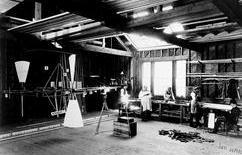
Langley's workshop in the South Shed of the Smithsonian, circa 1900.
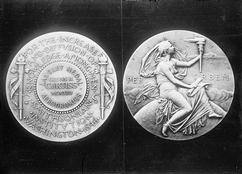
The Langley Medal that was awarded to Glenn Curtiss.
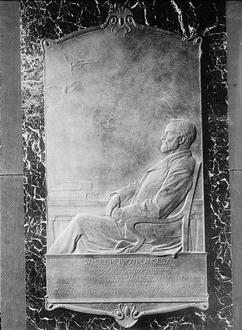
The Langley Tablet unveiled at the Smithsonian in 1913.
|